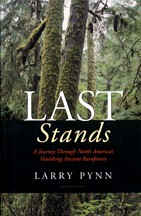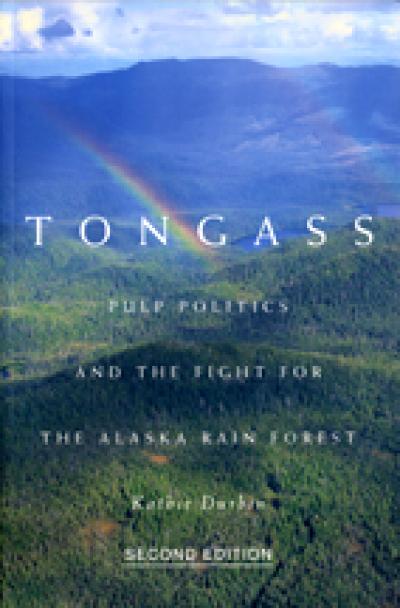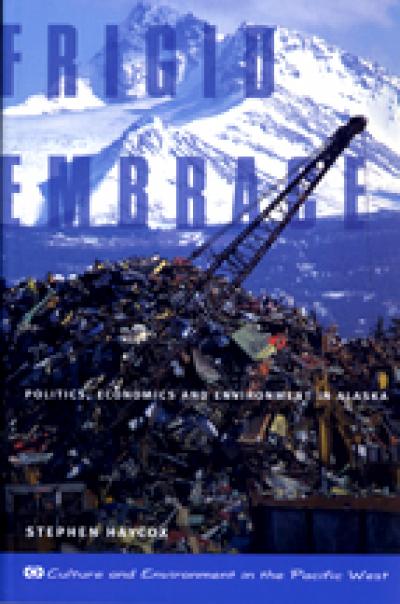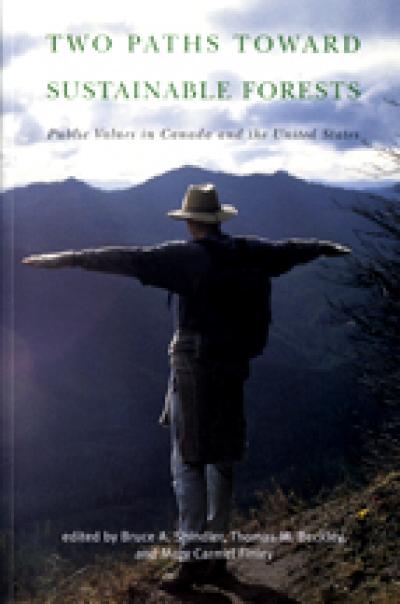
Last Stands
Larry Pynn
New Star Books
The remarkable Pacific temperate rainforest has become an endangered landscape, rarer than even the embattled tropical rainforest. In Last Stands, award-winning environmental writer Larry Pynn plunges into coastal forests from California to Alaska to explore this unique ecosystem and the complex factors that threaten it.
Whether standing with new-age loggers as they toil beneath the churning blades of a heli-logging operation, witnessing the wolverine's legendary ferocity, bounding along in the back of a pickup with a couple of bear hunters, or embarking on a week-long solo hike through an uncharted wilderness, Pynn's approach to understanding North America's temperate rainforest--and the creatures and people connected to it--is as diverse and unconventional as the forest itself. The result is a fascinating book, one part impassioned travelogue and one part natural history.
Cathedral, cash crop, the Earth's respiratory system: the rainforest is all this and more. The incalculable wealth and magnificence of these last stands spring forth in this savvy, down-to-earth chronicle.
About the author
Larry Pynn is the award-winning environmental reporter for the Vancouver Sun and the author of The Forgotten Trail: One Man's Adventures on the Canadian Route to the Klondike (Doubleday). He lives in Tsawwassen, British Columbia.
Read more about this author
Foreword
Introduction
- Seabirds on the Edge
The Sunshine Coast's Marbled Murrelets - Written in the Wood
The Western Red Cedars of Cascadia - Winter of the Devil Bear
Wolverines of the Columbia Mountains - The Cruelest Cut
The Tlingits of Southeast Alaska - Through the Eyes of the Nitinat Chief
Logging British Columbia's Central Coast - The Land of Bleeding Giants
California's Redwoods - Bear Country
Fight at the Top of the Food Chain - The Secret World of Mushrooms
Oregon's Mushroom Mafia - The Interior Rainforest
Seven Days Solo in the Granby Wilderness - On Your Knees for Alaska Man
Prince of Wales Island's Limestone Caves - The Sky Loggers
Harvesting by Helicopter - The Salmon Forest
Death and Rebirth on Chichagof Island
Epilogue
Index
A quarter of a century ago I viewed the rainforest not as a magnificent, complex landscape, but as sawed-up chunks and slabs of western red cedar produced by the mill where I worked in suburban Vancouver.
Sometimes I labored on the green chain, handing off heavy blocks of ancient wood to a sawyer to be hewn into commercial shakes and shingles for residential construction. On other occasions I stacked bundles onto semi-trailer trucks to be shipped to markets throughout the Pacific Northwest. Once I even tried an unsuccessful stint on the water, using a pike pole to haul raw logs up to a cutoff saw, a career mercifully sliced short when I fell in the Fraser River halfway through my first shift.
But as a teenager growing up in the early 1970s, most of my weekend worked occurred on Sundays, alone, when the mill was closed. For eight hours and without any breathing protection I endured toxic clouds of ash and obscenely high temperatures while cleaning crusty, smoldering mounds of rendered wood waste--rainforest meltdown--inside the guts of a beehive burner. Like a good soldier of fortune (a union wage of $4.45 an hour allowed me an outboard ski boat, 350 cc Yamaha motorcycle, and "65 Chevy), I dutifully followed my supervisor's orders and hauled the ash by wheelbarrow to the shores of the Fraser River. There I paused for a moment to ensure no authorities were in view, then dumped it down the river bank and returned to the hive for more. Over and over, weekend after weekend. I now rationalize my actions by arguing that I was young and it was a different era, a time when environmentalism was still finding its wobbly legs. But to this day I regret what I did. That I mention it here is not so much an act of catharsis as an indicator of the starting point for my unlikely journey to environmental writing.
Not that the journey ever really ends, of course; one's thoughts on logging and conservation continue to evolve with every new foray in the bush. I have covered more that 300,000 kilometres in twelve years in my two-wheel-drive Toyota pickup truck -- ole Bessie -- much of that bouncing around the labyrinth of logging roads that lace the industrial sole of British Columbia. I have seen much and talked to many people during that time. In doing so, I have inevitably forged certain sympathies for the plight of the Pacific temperate rainforest, a misunderstood place that suffers from the obscenity of polarized debate.
It occurred to me three years ago, when I first waded into the waters of this project, that there was much to be said about the rainforest that could not be told in the confines of a daily newspaper or a photo-filled coffee-table book. I also concluded that to tell the broader story, to journey first-hand through this unexplored void, I must adopt an approach as diverse and unconventional as the rainforest itself. I chose to travel along the 4,000 kilometres of western North America, from northern California to southeastern Alaska, seeking out as many perspectives, as many parts of the whole, as possible, in order to paint a more complete portrait of the temperate rainforest. I would ride along with black-bear hunters; stand with new-age loggers as they toiled beneath the lethal, churning blades of a heli-logging operation; glimpse the precarious reality behind the wolverine's legendary ferocity; travel old logging roads that are bleeding away the redwoods; explore the mysterious life-preserving resins that make red cedar the cultural lifeblood of the rainforest; go under-ground in search of the rainforest's oldest human bones; and fulfill my own destiny in week-long solo hike through an uncharted wilderness. All seemingly desperate experiences, yet each representative of an ecological thread that binds, or, in some cases, tears apart the rainforest.
Along the way I spent considerable time with scientists, whose voices are too often silenced by the din of political rhetoric. It is not that I dismiss the opinions of people who lack a science degree. Far from it. I do not have one myself and would like to think I have something to say on the subject. It is just that scientists are at the forefront of our knowledge of the rainforest.
Certain matters of natural history should be explained right from the outset. The first and most obvious issue is the definition of a temperate rainforest. Anyone caught camping unprepared during a prolonged rainstorm on the Pacific coast has a very personal definition and I am no different. As a neophyte outdoors man fifteen years ago, I went camping in the upper reaches of Lynn Creek in the Coast Mountains immediately north of Vancouver. The spring had been typically wet, the rainforest dripping with humidity. Unable to even light a newspaper to kickstart a campfire, I was forced to subsist on raw rations, including boil-in-a-bag Chinese food, while the weather ranged from pelting rain to wet, driving snow. Ultimately, I realized, the rainforest is a state of mind.
Ecologists understand rainforests as consisting largely of vegetation that thrives in wet conditions, which, on the West Coast, is loosely understood to be at least 200 centimetres or 80 inches of precipitation annually. On the Pacific coast of my home province of British Columbia, that primarily covers two biogeoclimatic zones where moist temperate air trapped by the coastal mountains creates the rain that nourishes the forests: the coastal western hemlock zone, including the Coast Range and the west side of both Vancouver Island and the Cascade Mountains; and the mountain hemlock zone, located at higher elevations along the coast. A third temperate rain-forest is the Interior cedar-hemlock zone, found in pockets of mountainous terrain several hours' drive east of the Pacific Ocean.
Of course, mean figures do not accurately reflect the sort of extreme lashing a rainforest is capable of dishing out. Henderson Lake, on the west coast of Vancouver Island, in 1997 set a Canadian rainfall record of nine metres for the year, 5.5 times the amount recorded at Vancouver International Airport. The lone occupants of this place are Bruce and Joanne Hepburn, operators of a salmon hatchery at the end of the boomerang-shaped lake that is surrounded by mountains and exposed to the full brunt of the Pacific winds. Their clothes closet is loaded with rubber boots and raingear, but not a single umbrella. "You see people in Vancouver with umbrellas, walking along with frowns on their faces when it rains," Bruce told me when I paid a visit by chartered float plane. "But out here, where you know it's going to rain, you get used to it, you get around it."
The temperate rainforests of North America's Pacific coast are also distinguished by their preponderance of coniferous evergreens--softwood species such as western red cedar, western hemlock, Douglas fir, Sitka spruce--growing year-round in mild, wet conditions. These softwoods make for a landscape that may lack the East Coast's spectacular displays of autumn colors, but more than compensates with an emerald broadloom that remains lush and vibrant through-out the year. The most remarkable of these coastal temperate rainforests feature the last stands of ancient old growth, trees as broad as buses and tall as apartment buildings; trees at least 250 years old but capable of living well beyond 1,000 years.
Old-growth forests are special for their beauty and the diversity of life forms they support, including the thousands of so-called lesser species, of which we know so little, from ground-dwelling fungi to canopy-loving lichen and insects. At least 380 vertebrate wildlife species occur in the coastal rainforest; 262 of them are birds, almost two-thirds of which use old-growth stands to one degree or another for nesting, feeding, or roosting. Threatened species such as the northern spotted owl are especially vulnerable because clearcutting continually shrinks their old-growth habitat, and leaves no hope they will ever get back. Replanted with selected commercial tree species that grow up as even-aged stands, these second-growth forests may be logged again in 50 years, long before they can regain their old-growth magnificence.
Allowed to generate on its own, an old-growth rainforest becomes a fantastic mosaic supporting a wealth of plant species in various stages of growth and decay. Death has no meaning in these surroundings. Even seemingly lifeless standing snags support a host of wildlife--no fewer than nineteen species of mammals and thirty-seven species of birds, either breeding or hibernating, including squirrels, marten, owls, and woodpeckers--while fallen timber rots and nurses the next generation of rainforest seedlings.
The Portland-based environmental group Ecotrust estimates that almost half the 25 million hectares of coastal temperate rainforests that once covered North America--an area equal to the state of Oregon--has already been lost to logging, agriculture, and other urban development. In the United States portion of that rainforest, only the Elwah River in Washington, Taylor Creek in Oregon, and Big Sur River in California are mostly undeveloped. The policy group World Resources Institute, based in Washington, D.C. found that Canada, Russia, and Brazil house almost 70% of the world's remaining original forests, and that only 3% of those are located in a temperate zone, representing "the most endangered frontier forests of all." In Washington and Oregon, the institute reports, the total area of old-growth forest now amounts to slightly over one million hectares--just 13% of the original amount--of which only about half is protected in national parks or wilderness areas.
The Sierra Club of British Columbia, meanwhile, estimates that more than half of the province's original rainforest has been logged and that no more than 69 of 353 watersheds larger than 5,000 hectares remain in pristine condition. Using the concept of the "great Bear Rainforest" as their sales pitch, British Columbia conservationists have launched a multi-pronged campaign--using logging road blockades, international boycotts, and political letter writing--to save these final vestiges of old-growth rainforests on the province's remote and sparsely populated central and north coast. A coalition of groups has called for an end to clearcutting and roadbuilding in these last unlogged valleys. A member of the campaign, Greenpeace, argues that half the world's temperate rainforests have been destroyed--a crisis far more urgent than the disappearance of the tropical rainforests--and shifts a greater ecological responsibility onto British Columbia, home to a quarter of what remains.
As both the forest industry and the conservation movement continue to debate how much old growth is enough, it is indisputable that much has already vanished and whatever remains is increasingly vulnerable to clearcut logging. But I am not so jaded by politics or journalism as to believe that the rainforests have reached a point of no return. Not for a minute. To watch a rainforest storm is still one of the world's most life-affirming experiences--at times frightening, always mesmerizing, and, in the end, hope-inspiring.
While researching this book I was rejuvenated by many a rain-storm, but none so awe-inspiring as the storm that struck late one September afternoon at my Prairie Creek campsite in the redwood forests of northern California. As the dark clouds boiled above the upper canopy, I stoked the campfire and huddled beneath a small blue tarp I had suspended with bungee cords from a big-leaf maple. The storm began tentatively enough, neat droplets spilling off the cloud rim, free-falling in slow motion, and landing with grenade force on the hapless creatures inhabiting the miniature world of the forest floor. From my perspective, the temperate rainforest seemed all legs, my pickup truck nothing more than a metallic blue toenail among the gigantic feet of old-growth redwoods and Sitka spruce. As vulnerable as I felt, to venture out would have been suicidal; anyone exposed to these elements for long would almost certainly wilt, liquefy, and eventually leach into the soil to feed the next flush of forest.
As the storm gained momentum, the upper canopy began to sag, and the rain bounced off the exposed roadway with the energy of water on a hot skillet. Strong winds hurried the rain along in the undulating waves, vertical sheets of water sidestepped their way through the campsite. Thunder rattled off the rolling mountains with the resounding snap of billiard balls on a hardwood cue. Lightning bolts hurtled across the sky, illuminating the nighttime landscape with the intensity of a neon forest fire. And to make the maelstrom complete, a red alder tree groaned under the weight of the storm, snapped in half, and disintegrated with a thunderous roar just across the creek.
The storm was a tumultuous, humbling spectacle. It was also a moment of spiritual and biological reawakening, a time when the forest seemed born again with the intensity of a revival meeting I felt the land shudder to life, saw the restless limbs stretch skyward, watched the sword ferns unfurl their emerald scrolls, heard the mushrooms popout of the ground with the intensity of champagne corks. Bring it on. Let the celebration begin.
"Larry Pynn writes with a naturalist's eye, a reporter's ear, and an environmentalists heart. Anyone who cares about the fate of our Pacific coast should take a journey with Pynn through Last Stands."
Hiking on the Edge: West Coast Trail and Juan de Fuca Trail




